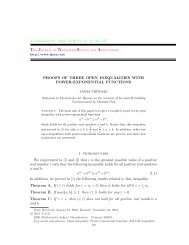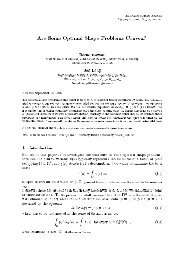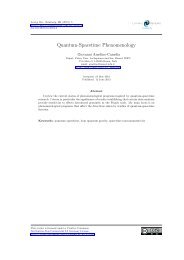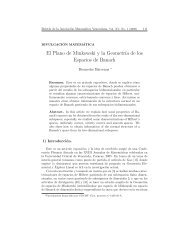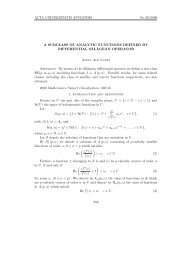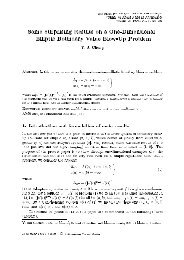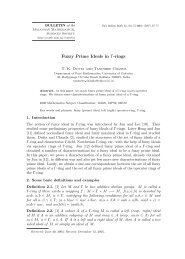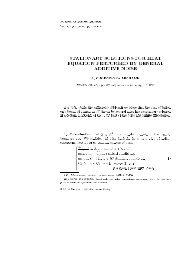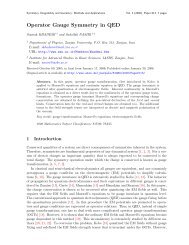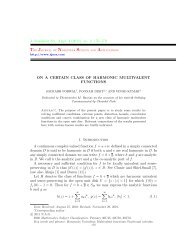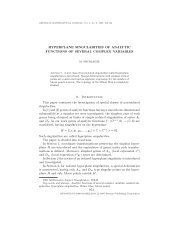Hyers-Ulam-Rassias stability of homomorphisms in quasi-Banach ...
Hyers-Ulam-Rassias stability of homomorphisms in quasi-Banach ...
Hyers-Ulam-Rassias stability of homomorphisms in quasi-Banach ...
- No tags were found...
You also want an ePaper? Increase the reach of your titles
YUMPU automatically turns print PDFs into web optimized ePapers that Google loves.
<strong>Banach</strong> J. Math. Anal. 1 (2007), no. 1, 23–32<strong>Banach</strong> Journal <strong>of</strong> Mathematical AnalysisISSN: 1735-8787 (electronic)http://www.math-analysis.orgHYERS–ULAM–RASSIAS STABILITY OF HOMOMORPHISMSIN QUASI-BANACH ALGEBRASCHUN-GIL PARK 1This paper is dedicated to Pr<strong>of</strong>essor Themistocles M. <strong>Rassias</strong>.Submitted by P. K. SahooAbstract. Let q be a positive rational number and n be a nonnegative <strong>in</strong>teger.We prove the <strong>Hyers</strong>–<strong>Ulam</strong>–<strong>Rassias</strong> <strong>stability</strong> <strong>of</strong> <strong>homomorphisms</strong> <strong>in</strong> <strong>quasi</strong>-<strong>Banach</strong> algebras and <strong>of</strong> generalized derivations on <strong>quasi</strong>-<strong>Banach</strong> algebras forthe follow<strong>in</strong>g functional equation:⎛⎞ (n∑ n∑n)∑n∑f ⎝ q(x i − x j ) ⎠ + nf qx i = nq f(x i ).i=1j=1This is applied to <strong>in</strong>vestigate isomorphisms between <strong>quasi</strong>-<strong>Banach</strong> algebras. Theconcept <strong>of</strong> <strong>Hyers</strong>–<strong>Ulam</strong>–<strong>Rassias</strong> <strong>stability</strong> orig<strong>in</strong>ated from the Th.M. <strong>Rassias</strong>’<strong>stability</strong> theorem that appeared <strong>in</strong> his paper: On the <strong>stability</strong> <strong>of</strong> the l<strong>in</strong>earmapp<strong>in</strong>g <strong>in</strong> <strong>Banach</strong> spaces, Proc. Amer. Math. Soc. 72 (1978), 297–300.i=1i=11. Introduction and prelim<strong>in</strong>aries<strong>Ulam</strong> [30] gave a talk before the Mathematics Club <strong>of</strong> the University <strong>of</strong> Wiscons<strong>in</strong><strong>in</strong> which he discussed a number <strong>of</strong> unsolved problems. Among these was thefollow<strong>in</strong>g question concern<strong>in</strong>g the <strong>stability</strong> <strong>of</strong> <strong>homomorphisms</strong>.We are given a group G and a metric group G ′ with metric ρ(·, ·). Given ɛ > 0,does there exist a δ > 0 such that if f : G → G ′ satisfiesρ(f(xy), f(x)f(y)) < δDate: Received: 3 March 2007; Accepted: 16 October 2007.2000 Mathematics Subject Classification. Primary 39B52; Secondary 46B03, 47Jxx.Key words and phrases. <strong>Hyers</strong>–<strong>Ulam</strong>–<strong>Rassias</strong> <strong>stability</strong>, functional equation, homomorphism<strong>in</strong> <strong>quasi</strong>-<strong>Banach</strong> algebra, p-<strong>Banach</strong> algebra, generalized derivation.23
24 C. PARKfor all x, y ∈ G, then a homomorphism h : G → G ′ exists with ρ(f(x), h(x)) < ɛfor all x ∈ G?By now an affirmative answer has been given <strong>in</strong> several cases, and some <strong>in</strong>terest<strong>in</strong>gvariations <strong>of</strong> the problem have also been <strong>in</strong>vestigated. We shall call suchan f : G → G ′ an approximate homomorphism.<strong>Hyers</strong> [11] considered the case <strong>of</strong> approximately additive mapp<strong>in</strong>gs f : E → E ′ ,where E and E ′ are <strong>Banach</strong> spaces and f satisfies <strong>Hyers</strong> <strong>in</strong>equality‖f(x + y) − f(x) − f(y)‖ ≤ ɛfor all x, y ∈ E. It was shown that the limitL(x) = limn→∞f(2 n x)2 nexists for all x ∈ E and that L : E → E ′ is the unique additive mapp<strong>in</strong>g satisfy<strong>in</strong>g‖f(x) − L(x)‖ ≤ ɛ.No cont<strong>in</strong>uity conditions are required for this result, but if f(tx) is cont<strong>in</strong>uous <strong>in</strong>the real variable t for each fixed x ∈ E, then L is l<strong>in</strong>ear, and if f is cont<strong>in</strong>uousat a s<strong>in</strong>gle po<strong>in</strong>t <strong>of</strong> E then L : E → E ′ is also cont<strong>in</strong>uous.Th.M. <strong>Rassias</strong> [24] provided a generalization <strong>of</strong> <strong>Hyers</strong>’ Theorem which allowsthe Cauchy difference to be unbounded.Theorem 1.1. (Th.M. <strong>Rassias</strong>). Let f : E → E ′ be a mapp<strong>in</strong>g from a normedvector space E <strong>in</strong>to a <strong>Banach</strong> space E ′ subject to the <strong>in</strong>equality‖f(x + y) − f(x) − f(y)‖ ≤ ɛ(‖x‖ p + ‖y‖ p ) (1.1)for all x, y ∈ E, where ɛ and p are constants with ɛ > 0 and p < 1. Then thelimitf(2 n x)L(x) = limn→∞ 2 nexists for all x ∈ E and L : E → E ′ is the unique additive mapp<strong>in</strong>g which satisfies‖f(x) − L(x)‖ ≤2ɛ2 − 2 p ‖x‖p (1.2)for all x ∈ E. If p < 0 then <strong>in</strong>equality (1.1) holds for x, y ≠ 0 and (1.2) for x ≠ 0.Also, if for each x ∈ E the mapp<strong>in</strong>g f(tx) is cont<strong>in</strong>uous <strong>in</strong> t ∈ R for each fixedx ∈ E, then L is l<strong>in</strong>ear.Th.M. <strong>Rassias</strong> [25] dur<strong>in</strong>g the 27 th International Symposium on FunctionalEquations asked the question whether such a theorem can also be proved forp ≥ 1. Gajda [9] follow<strong>in</strong>g the same approach as <strong>in</strong> Th.M. <strong>Rassias</strong> [24], gave anaffirmative solution to this question for p > 1. It was shown by Gajda [9], aswell as by Th.M. <strong>Rassias</strong> and Šemrl [28] that one cannot prove a Th.M. <strong>Rassias</strong>’type Theorem when p = 1. The counterexamples <strong>of</strong> Gajda [9], as well as <strong>of</strong>Th.M. <strong>Rassias</strong> and Šemrl [28] have stimulated several mathematicians to <strong>in</strong>ventnew def<strong>in</strong>itions <strong>of</strong> approximately additive or approximately l<strong>in</strong>ear mapp<strong>in</strong>gs, cf.Găvruta [10], Czerwik [7], who among others studied the <strong>Hyers</strong>–<strong>Ulam</strong> <strong>stability</strong><strong>of</strong> functional equations. The <strong>in</strong>equality (1.1) that was <strong>in</strong>troduced for the firsttime by Th.M. <strong>Rassias</strong> [24] provided a lot <strong>of</strong> <strong>in</strong>fluence <strong>in</strong> the development <strong>of</strong>
STABILITY OF HOMOMORPHISMS IN QUASI-BANACH ALGEBRAS 25a generalization <strong>of</strong> the <strong>Hyers</strong>–<strong>Ulam</strong> <strong>stability</strong> concept. This concept is knownas <strong>Hyers</strong>–<strong>Ulam</strong>–<strong>Rassias</strong> <strong>stability</strong> <strong>of</strong> functional equations (cf. the books <strong>of</strong> D.H.<strong>Hyers</strong>, G. Isac and Th.M. <strong>Rassias</strong> [12], S. Jung [16], P. Czerwik [8]; the papers <strong>of</strong>C. Baak and M.S. Moslehian [4], K. Jun, S. Jung and Y. Lee [13], Y. Lee and K.Jun [17], C. Park [19], C. Park and J. Hou [22], C. Park and Th.M. <strong>Rassias</strong> [23],Th.M. <strong>Rassias</strong> [26, 27]).Beg<strong>in</strong>n<strong>in</strong>g around the year 1980, the topic <strong>of</strong> approximate <strong>homomorphisms</strong>and their <strong>stability</strong> theory <strong>in</strong> the field <strong>of</strong> functional equations and <strong>in</strong>equalities wastaken up by several mathematicians (cf. [12] and the references there<strong>in</strong>).Recently, Jun and Kim [14] solved the <strong>stability</strong> problem <strong>of</strong> <strong>Ulam</strong> for a quadraticfunctional equation. Jun and Kim [15] <strong>in</strong>troduced and <strong>in</strong>vestigated the follow<strong>in</strong>gquadratic functional equation(n∑ n∑) ( n∑) ( n∑)r i Q r j (x i − x j ) + r i Q r i x ii=1 j=1i=1i=1( n∑) 2 n∑= r i r i Q(x i ).i=1In this paper we <strong>in</strong>troduce the follow<strong>in</strong>g functional equation(n∑ n∑) ( n∑)n∑L q(x i − x j ) + nL qx i = nq L(x i ). (1.3)i=1 j=1i=1i=1The purpose <strong>of</strong> the present paper is to study the <strong>Hyers</strong>–<strong>Ulam</strong>–<strong>Rassias</strong> <strong>stability</strong><strong>of</strong> the functional equation (1.3).We recall some basic facts concern<strong>in</strong>g <strong>quasi</strong>-<strong>Banach</strong> spaces and some prelim<strong>in</strong>aryresults.Def<strong>in</strong>ition 1.2. ([6, 29]) Let X be a real l<strong>in</strong>ear space. A <strong>quasi</strong>-norm is areal-valued function on X satisfy<strong>in</strong>g the follow<strong>in</strong>g:(1) ‖x‖ ≥ 0 for all x ∈ X and ‖x‖ = 0 if and only if x = 0.(2) ‖λx‖ = |λ| · ‖x‖ for all λ ∈ R and all x ∈ X.(3) There is a constant K ≥ 1 such that ‖x + y‖ ≤ K(‖x‖ + ‖y‖) for allx, y ∈ X.The pair (X, ‖ · ‖) is called a <strong>quasi</strong>-normed space if ‖ · ‖ is a <strong>quasi</strong>-norm on X.The smallest possible K is called the modulus <strong>of</strong> concavity <strong>of</strong> ‖·‖. Obviously theballs with respect to ‖ · ‖ def<strong>in</strong>e a l<strong>in</strong>ear topology on X. By a <strong>quasi</strong>-<strong>Banach</strong> spacewe mean a complete <strong>quasi</strong>-normed space, i.e. a <strong>quasi</strong>-normed space <strong>in</strong> which every‖ · ‖-Cauchy sequence <strong>in</strong> X converges. This class <strong>in</strong>cludes <strong>Banach</strong> spaces and themost significant class <strong>of</strong> <strong>quasi</strong>-<strong>Banach</strong> spaces which are not <strong>Banach</strong> spaces arethe L p spaces for 0 < p < 1 with the <strong>quasi</strong>-norm ‖ · ‖ p .A <strong>quasi</strong>-norm ‖ · ‖ is called a p-norm (0 < p ≤ 1) if‖x + y‖ p ≤ ‖x‖ p + ‖y‖ pfor all x, y ∈ X. In this case, a <strong>quasi</strong>-<strong>Banach</strong> space is called a p-<strong>Banach</strong> space.i=1
26 C. PARKGiven a p-norm, the formula d(x, y) := ‖x−y‖ p gives us a translation <strong>in</strong>variantmetric on X. By the Aoki–Rolewicz theorem [29] (see also [6]), each <strong>quasi</strong>-normis equivalent to some p-norm. S<strong>in</strong>ce it is much easier to work with p-norms than<strong>quasi</strong>-norms, henceforth we restrict our attention ma<strong>in</strong>ly to p-norms.Def<strong>in</strong>ition 1.3. ([2]) Let (A, ‖ · ‖) be a <strong>quasi</strong>-normed space. The <strong>quasi</strong>-normedspace (A, ‖ · ‖) is called a <strong>quasi</strong>-normed algebra if A is an algebra and there is aconstant K > 0 such that ‖xy‖ ≤ K‖x‖ · ‖y‖ for all x, y ∈ A.A <strong>quasi</strong>-<strong>Banach</strong> algebra is a complete <strong>quasi</strong>-normed algebra.If the <strong>quasi</strong>-norm ‖ · ‖ is a p-norm then the <strong>quasi</strong>-<strong>Banach</strong> algebra is called ap-<strong>Banach</strong> algebra.In this paper, assume that A is a <strong>quasi</strong>-normed algebra with <strong>quasi</strong>-norm ‖ · ‖ Aand that B is a p-<strong>Banach</strong> algebra with p-norm ‖ · ‖ B . Let K be the modulus <strong>of</strong>concavity <strong>of</strong> ‖ · ‖ B .This paper is organized as follows: In Section 2, we prove the <strong>Hyers</strong>–<strong>Ulam</strong>–<strong>Rassias</strong> <strong>stability</strong> <strong>of</strong> <strong>homomorphisms</strong> <strong>in</strong> <strong>quasi</strong>-<strong>Banach</strong> algebras.In Section 3, we <strong>in</strong>vestigate isomorphisms between <strong>quasi</strong>-<strong>Banach</strong> algebras.In Section 4, we prove the <strong>Hyers</strong>–<strong>Ulam</strong>–<strong>Rassias</strong> <strong>stability</strong> <strong>of</strong> generalized derivationson <strong>quasi</strong>-<strong>Banach</strong> algebras.2. Stability <strong>of</strong> <strong>homomorphisms</strong> <strong>in</strong> <strong>quasi</strong>-<strong>Banach</strong> algebrasLet q be a positive rational number. For a given mapp<strong>in</strong>g f : A → B, we def<strong>in</strong>eDf : A n → B by(n∑ n∑)Df(x 1 , · · · , x n ) : = f q(x i − x j )i=1 j=1( n∑)n∑+ nf qx i − nq f(x i )i=1i=1for all x 1 , · · · , x n ∈ X.We prove the <strong>Hyers</strong>–<strong>Ulam</strong>–<strong>Rassias</strong> <strong>stability</strong> <strong>of</strong> <strong>homomorphisms</strong> <strong>in</strong> <strong>quasi</strong>-<strong>Banach</strong>algebras.Theorem 2.1. Assume that r > 2 if nq > 1 and that 0 < r < 1 if nq < 1. Let θbe a positive real number, and let f : A → B be an odd mapp<strong>in</strong>g such thatn∑‖Df(x 1 , · · · , x n )‖ B ≤ θ ‖x j ‖ r A, (2.1)j=1‖f(xy) − f(x)f(y)‖ B ≤ θ(‖x‖ r A + ‖y‖ r A) (2.2)for all x, y, x 1 , · · · , x n ∈ A. If f(tx) is cont<strong>in</strong>uous <strong>in</strong> t ∈ R for each fixed x ∈ A,then there exists a unique homomorphism H : A → B such thatθ‖f(x) − H(x)‖ B ≤‖x‖ r((nq) pr − (nq) p ) 1 A (2.3)pfor all x ∈ A.
STABILITY OF HOMOMORPHISMS IN QUASI-BANACH ALGEBRAS 27Pro<strong>of</strong>. Lett<strong>in</strong>g x 1 = · · · = x n = x <strong>in</strong> (2.1), we get‖nf(nqx) − n 2 qf(x)‖ B ≤ nθ‖x‖ r Afor all x ∈ A. So‖f(x) − nqf( x nq )‖ B ≤θ(nq) r ‖x‖r Afor all x ∈ A. S<strong>in</strong>ce B is a p-<strong>Banach</strong> algebra,‖(nq) l xf((nq) ) − xl (nq)m f((nq) m )‖p B≤≤m−1∑j=l‖(nq) j xf((nq) ) − xj (nq)j+1 f((nq) j+1 )‖p B(2.4)θ p m−1∑ (nq) pj(nq) pr ‖x‖pr(nq)prj Aj=lfor all nonnegative <strong>in</strong>tegers m and l with m > l and all x ∈ A. It follows from(2.4) that the sequence {(nq) d f( x )} is Cauchy for all x ∈ A. S<strong>in</strong>ce B is(nq) dcomplete, the sequence {(nq) d f( x )} converges. So one can def<strong>in</strong>e the mapp<strong>in</strong>g(nq) dH : A → B byH(x) := lim (nq) d xf(d→∞ (nq) ) dfor all x ∈ A. Moreover, lett<strong>in</strong>g l = 0 and pass<strong>in</strong>g the limit m → ∞ <strong>in</strong> (2.4), weget (2.3).It follows from (2.1) that‖DH(x 1 , · · · , x n )‖ B = lim (nq) d ‖Df( x 1d→∞ (nq) , · · · , x nd (nq) )‖ d Bfor all x 1 , · · · , x n ∈ A. Thus≤(nq) d θlimd→∞ (nq) drn∑‖x j ‖ r A = 0j=1DH(x 1 , · · · , x n ) = 0for all x 1 , · · · , x n ∈ A. By Lemma 2.1 <strong>of</strong> [21], the mapp<strong>in</strong>g H : A → B is Cauchyadditive.By the same reason<strong>in</strong>g as <strong>in</strong> the pro<strong>of</strong> <strong>of</strong> Theorem <strong>of</strong> [24], the mapp<strong>in</strong>g H :A → B is R-l<strong>in</strong>ear.It follows from (2.2) that‖H(xy) − H(x)H(y)‖ B= lim (nq) 2d xy‖f(d→∞ (nq) d (nq) ) − f( xd (nq) )f( yd (nq) )‖ d Bfor all x, y ∈ A. So≤(nq) 2d θlimd→∞ (nq) dr (‖x‖r A + ‖y‖ r A) = 0H(xy) = H(x)H(y)
28 C. PARKfor all x, y ∈ A.Now, let T : A → B be another mapp<strong>in</strong>g satisfy<strong>in</strong>g (2.3). Then we have‖H(x) − T (x)‖ B = (nq) d x‖H((nq) ) − T ( xd (nq) )‖ d B≤ (nq) d xK(‖H((nq) ) − f( xd (nq) )‖ xd B + ‖T ((nq) ) − f( xd (nq) )‖ B)d≤2 · (nq) d Kθ((nq) pr − (nq) p ) 1 p (nq)dr ‖x‖r A,which tends to zero as n → ∞ for all x ∈ A. So we can conclude that H(x) = T (x)for all x ∈ A. This proves the uniqueness <strong>of</strong> H. Thus the mapp<strong>in</strong>g H : A → Bis a unique homomorphism satisfy<strong>in</strong>g (2.3).□Theorem 2.2. Assume that 0 < r < 1 if nq > 1 and that r > 2 if nq < 1. Let θbe a positive real number, and let f : A → B be an odd mapp<strong>in</strong>g satisfy<strong>in</strong>g (2.1)and (2.2). If f(tx) is cont<strong>in</strong>uous <strong>in</strong> t ∈ R for each fixed x ∈ A, then there existsa unique homomorphism H : A → B such thatfor all x ∈ A.‖f(x) − H(x)‖ B ≤Pro<strong>of</strong>. It follows from (2.1) thatθ‖x‖ r((nq) p − (nq) pr ) 1 A (2.5)p‖f(x) − 1 nq f(nqx)‖ B ≤ θ nq ‖x‖r Afor all x ∈ A. S<strong>in</strong>ce B is a p-<strong>Banach</strong> algebra,‖ 1(nq) l f((nq)l x)−≤≤1(nq) m f((nq)m x)‖ p Bm−1∑j=l‖ 1(nq) j f((nq)j x) −θ p m−1∑(nq) pj=l(nq) prj‖x‖pr(nq)pj A1(nq) j+1 f((nq)j+1 x)‖ p B (2.6)for all nonnegative <strong>in</strong>tegers m and l with m > l and all x ∈ A. It followsfrom (2.6) that the sequence { 1 f((nq) d x)} is Cauchy for all x ∈ A. S<strong>in</strong>ce(nq) dB is complete, the sequence { 1 f((nq) d x)} converges. So one can def<strong>in</strong>e the(nq) dmapp<strong>in</strong>g H : A → B by1H(x) := limd→∞ (nq) d f((nq)d x)for all x ∈ A. Moreover, lett<strong>in</strong>g l = 0 and pass<strong>in</strong>g the limit m → ∞ <strong>in</strong> (2.6), weget (2.5).The rest <strong>of</strong> the pro<strong>of</strong> is similar to the pro<strong>of</strong> <strong>of</strong> Theorem 2.1.□
STABILITY OF HOMOMORPHISMS IN QUASI-BANACH ALGEBRAS 293. Isomorphisms between <strong>quasi</strong>-<strong>Banach</strong> algebrasThroughout this section, assume that A is a <strong>quasi</strong>-<strong>Banach</strong> algebra with quas<strong>in</strong>orm‖ · ‖ A and unit e and that B is a p-<strong>Banach</strong> algebra with p-norm ‖ · ‖ B andunit e ′ . Let K be the modulus <strong>of</strong> concavity <strong>of</strong> ‖ · ‖ B .We <strong>in</strong>vestigate isomorphisms between <strong>quasi</strong>-<strong>Banach</strong> algebras.Theorem 3.1. Assume that r > 2 if nq > 1 and that 0 < r < 1 if nq < 1.Let θ be a positive real number, and let f : A → B be an odd bijective mapp<strong>in</strong>gsatisfy<strong>in</strong>g (2.1) such thatf(xy) = f(x)f(y) (3.1)for all x, y ∈ A. If lim d→∞ (nq) d ef( ) = e ′ and f(tx) is cont<strong>in</strong>uous <strong>in</strong> t ∈ R for(nq) deach fixed x ∈ A, then the mapp<strong>in</strong>g f : A → B is an isomorphism.Pro<strong>of</strong>. The condition (3.1) implies that f : A → B satisfies (2.2). By the samereason<strong>in</strong>g as <strong>in</strong> the pro<strong>of</strong> <strong>of</strong> Theorem 2.1, there exists a unique homomorphismH : A → B, which is def<strong>in</strong>ed byH(x) := lim (nq) d xf(d→∞ (nq) ) dfor all x ∈ A. ThusH(x) = H(ex) = lim (nq) d f( exd→∞ (nq) ) = lim ed d→∞ (nq)d f((nq) · x) d= lim (nq) d ef(d→∞ (nq) )f(x) = d e′ f(x) = f(x)for all x ∈ A.desired.So the bijective mapp<strong>in</strong>g f : A → B is an isomorphism, as□Theorem 3.2. Assume that 0 < r < 1 if nq > 1 and that r > 2 if nq < 1.Let θ be a positive real number, and let f : A → B be an odd bijective mapp<strong>in</strong>gsatisfy<strong>in</strong>g (2.1) and (3.1). If f(tx) is cont<strong>in</strong>uous <strong>in</strong> t ∈ R for each fixed x ∈ Aand lim d→∞1(nq) d f((nq) d e) = e ′ , then the mapp<strong>in</strong>g f : A → B is an isomorphism.Pro<strong>of</strong>. The pro<strong>of</strong> is similar to the pro<strong>of</strong>s <strong>of</strong> Theorems 2.1, 2.2 and 3.1.4. Stability <strong>of</strong> generalized derivations on <strong>quasi</strong>-<strong>Banach</strong> algebrasRecently, several extended notions <strong>of</strong> derivations have been treated <strong>in</strong> the <strong>Banach</strong>algebra theory (see [18] and references there<strong>in</strong>). In addition, the <strong>stability</strong> <strong>of</strong>these derivations is extensively studied by many mathematicians; see [1, 5, 20].Throughout this section, assume that A is a p-<strong>Banach</strong> algebra with p-norm‖ · ‖ A . Let K be the modulus <strong>of</strong> concavity <strong>of</strong> ‖ · ‖ A .Def<strong>in</strong>ition 4.1. [3] A generalized derivation δ : A → A is R-l<strong>in</strong>ear and fulfillsthe generalized Leibniz rulefor all x, y, z ∈ A.δ(xyz) = δ(xy)z − xδ(y)z + xδ(yz)□
30 C. PARKWe prove the <strong>Hyers</strong>–<strong>Ulam</strong>–<strong>Rassias</strong> <strong>stability</strong> <strong>of</strong> generalized derivations on <strong>quasi</strong>-<strong>Banach</strong> algebras.Theorem 4.2. Assume that r > 3 if nq > 1 and that 0 < r < 1 if nq < 1. Let θbe a positive real number, and let f : A → A be an odd mapp<strong>in</strong>g satisfy<strong>in</strong>g (2.1)such that‖f(xyz) − f(xy)z + xf(y)z − xf(yz)‖ A≤ θ(‖x‖ r A + ‖y‖ r A + ‖z‖ r A) (4.1)for all x, y, z ∈ A. If f(tx) is cont<strong>in</strong>uous <strong>in</strong> t ∈ R for each fixed x ∈ A, thenthere exists a unique generalized derivation δ : A → A such thatfor all x ∈ A.‖f(x) − δ(x)‖ A ≤θ‖x‖ r((nq) pr − (nq) p ) 1 A (4.2)pPro<strong>of</strong>. By the same reason<strong>in</strong>g as <strong>in</strong> the pro<strong>of</strong> <strong>of</strong> Theorem 2.1, there exists a uniqueR-l<strong>in</strong>ear mapp<strong>in</strong>g δ : A → A satisfy<strong>in</strong>g (4.2). The mapp<strong>in</strong>g δ : A → A is def<strong>in</strong>edbyδ(x) := lim (nq) d xf(d→∞ (nq) ) dfor all x ∈ A.It follows from (4.1) thatfor all x, y, z ∈ A. So‖δ(xyz) − δ(xy)z + xδ(y)z − xδ(yz)‖ A= lim (nq) 3d ‖f( xyz xy) − f(d→∞ (nq)3d(nq) ) z2d (nq) d+ x(nq) f( yd (nq) ) yd (nq) − xd (nq) f( yzd (nq) )‖ 2d A≤ limd→∞(nq) 3d θ(nq) dr (‖x‖r A + ‖y‖ r A + ‖z‖ r A) = 0δ(xyz) = δ(xy)z − xδ(y)z + xδ(yz)for all x, y, z ∈ A. Thus the mapp<strong>in</strong>g δ : A → A is a unique generalized derivationsatisfy<strong>in</strong>g (4.2).□Theorem 4.3. Assume that 0 < r < 1 if nq > 1 and that r > 3 if nq < 1. Let θbe a positive real number, and let f : A → A be an odd mapp<strong>in</strong>g satisfy<strong>in</strong>g (2.1)and (4.1). If f(tx) is cont<strong>in</strong>uous <strong>in</strong> t ∈ R for each fixed x ∈ A, then there existsa unique generalized derivation δ : A → A such thatfor all x ∈ A.‖f(x) − δ(x)‖ A ≤θ‖x‖ r((nq) p − (nq) pr ) 1 A (4.3)p
STABILITY OF HOMOMORPHISMS IN QUASI-BANACH ALGEBRAS 31Pro<strong>of</strong>. By the same reason<strong>in</strong>g as <strong>in</strong> the pro<strong>of</strong> <strong>of</strong> Theorem 2.2, there exists a uniqueR-l<strong>in</strong>ear mapp<strong>in</strong>g δ : A → A satisfy<strong>in</strong>g (4.3). The mapp<strong>in</strong>g δ : A → A is def<strong>in</strong>edby1δ(x) := limd→∞ (nq) d f((nq)d x)for all x ∈ A.The rest <strong>of</strong> the pro<strong>of</strong> is similar to the pro<strong>of</strong> <strong>of</strong> Theorem 4.2.□References1. M. Amyari, C. Baak and M.S. Moslehian, Nearly ternary derivations, Taiwanese J. Math.(to appear).2. J.M. Almira and U. Luther, Inverse closedness <strong>of</strong> approximation algebras, J. Math. Anal.Appl. 314 (2006), 30–44.3. P. Ara and M. Mathieu, Local Multipliers <strong>of</strong> C ∗ -Algebras, Spr<strong>in</strong>ger-Verlag, London, 2003.4. C. Baak and M.S. Moslehian, On the <strong>stability</strong> <strong>of</strong> J ∗ -<strong>homomorphisms</strong>, Nonl<strong>in</strong>ear Anal.–TMA63 (2005), 42–48.5. C. Baak and M.S. Moslehian, On the <strong>stability</strong> <strong>of</strong> θ-derivations on JB ∗ -triples, Bull. Braz.Math. Soc. 38 (2007), 115–127.6. Y. Benyam<strong>in</strong>i and J. L<strong>in</strong>denstrauss, Geometric Nonl<strong>in</strong>ear Functional Analysis, Vol. 1, Colloq.Publ. 48, Amer. Math. Soc., Providence, 2000.7. P. Czerwik, On <strong>stability</strong> <strong>of</strong> the quadratic mapp<strong>in</strong>g <strong>in</strong> normed spaces, Abh. Math. Sem.Hamburg 62 (1992), 59–64.8. P. Czerwik, Functional Equations and Inequalities <strong>in</strong> Several Variables, World ScientificPublish<strong>in</strong>g Company, New Jersey, Hong Kong, S<strong>in</strong>gapore and London, 2002.9. Z. Gajda, On <strong>stability</strong> <strong>of</strong> additive mapp<strong>in</strong>gs, Internat. J. Math. Math. Sci. 14 (1991), 431–434.10. P. Gǎvruta, A generalization <strong>of</strong> the <strong>Hyers</strong>–<strong>Ulam</strong>–<strong>Rassias</strong> <strong>stability</strong> <strong>of</strong> approximately additivemapp<strong>in</strong>gs, J. Math. Anal. Appl. 184 (1994), 431–436.11. D.H. <strong>Hyers</strong>, On the <strong>stability</strong> <strong>of</strong> the l<strong>in</strong>ear functional equation, Proc. Nat. Acad. Sci. U.S.A.27 (1941), 222–224.12. D.H. <strong>Hyers</strong>, G. Isac and Th.M. <strong>Rassias</strong>, Stability <strong>of</strong> Functional Equations <strong>in</strong> Several Variables,Birkhäuser, Basel, 1998.13. K. Jun, S. Jung and Y. Lee, A generalization <strong>of</strong> the <strong>Hyers</strong>–<strong>Ulam</strong>–<strong>Rassias</strong> <strong>stability</strong> <strong>of</strong> afunctional equation <strong>of</strong> Davison, J. Korean Math. Soc. 41 (2004), 501–511.14. K. Jun and H. Kim, <strong>Ulam</strong> <strong>stability</strong> problem for quadratic mapp<strong>in</strong>gs <strong>of</strong> Euler–Lagrange,Nonl<strong>in</strong>ear Anal.–TMA 61 (2005), 1093–1104.15. K. Jun and H. Kim, On the generalized A-quadratic mapp<strong>in</strong>gs associated with the variance<strong>of</strong> a discrete type distribution Nonl<strong>in</strong>ear Anal.–TMA 62 (2005), 975–987.16. S. Jung, <strong>Hyers</strong>–<strong>Ulam</strong>–<strong>Rassias</strong> Stability <strong>of</strong> Functional Equations <strong>in</strong> Mathematical Analysis,Hadronic Press, Palm Harbor, Florida, 2001.17. Y. Lee and K. Jun, A note on the <strong>Hyers</strong>–<strong>Ulam</strong>–<strong>Rassias</strong> <strong>stability</strong> <strong>of</strong> Pexider equation, J.Korean Math. Soc. 37 (2000), 111–124.18. M. Mirzavaziri and M.S. Moslehian, Automatic cont<strong>in</strong>uity <strong>of</strong> σ-derivations <strong>in</strong> C ∗ -algebras,Proc. Amer. Math. Soc. 134 (2006), 3319–3327.19. C. Park, On the <strong>stability</strong> <strong>of</strong> the l<strong>in</strong>ear mapp<strong>in</strong>g <strong>in</strong> <strong>Banach</strong> modules, J. Math. Anal. Appl.275 (2002), 711–720.20. C. Park, L<strong>in</strong>ear derivations on <strong>Banach</strong> algebras, Nonl<strong>in</strong>ear Funct. Anal. Appl. 9 (2004),359–368.21. C. Park, <strong>Hyers</strong>–<strong>Ulam</strong>–<strong>Rassias</strong> <strong>stability</strong> <strong>of</strong> a generalized Euler–Lagrange type additive mapp<strong>in</strong>gand isomorphisms between C ∗ -algebras, Bull. Belgian Math. Soc.–Simon Stev<strong>in</strong> 13(2006), 619–631.
32 C. PARK22. C. Park and J. Hou, Homomorphisms between C ∗ -algebras associated with the Trif functionalequation and l<strong>in</strong>ear derivations on C ∗ -algebras, J. Korean Math. Soc. 41 (2004),461–477.23. C. Park and Th.M. <strong>Rassias</strong>, On a generalized Trif’s mapp<strong>in</strong>g <strong>in</strong> <strong>Banach</strong> modules over aC ∗ -algebra, J. Korean Math. Soc. 43 (2006), 323–356.24. Th.M. <strong>Rassias</strong>, On the <strong>stability</strong> <strong>of</strong> the l<strong>in</strong>ear mapp<strong>in</strong>g <strong>in</strong> <strong>Banach</strong> spaces, Proc. Amer. Math.Soc. 72 (1978), 297–300.25. Th.M. <strong>Rassias</strong>, Problem 16; 2, Report <strong>of</strong> the 27 th International Symp. on Functional Equations,Aequationes Math. 39 (1990), 292–293; 309.26. Th.M. <strong>Rassias</strong>, On the <strong>stability</strong> <strong>of</strong> functional equations <strong>in</strong> <strong>Banach</strong> spaces, J. Math. Anal.Appl. 251 (2000), 264–284.27. Th.M. <strong>Rassias</strong>, Functional Equations, Inequalities and Applications, Kluwer Academic Publishers,Dordrecht, Boston and London, 2003.28. Th.M. <strong>Rassias</strong> and P. Šemrl, On the behaviour <strong>of</strong> mapp<strong>in</strong>gs which do not satisfy <strong>Hyers</strong>–<strong>Ulam</strong><strong>stability</strong>, Proc. Amer. Math. Soc. 114 (1992), 989–993.29. S. Rolewicz, Metric L<strong>in</strong>ear Spaces, PWN-Polish Sci. Publ., Reidel and Dordrecht, 1984.30. S.M. <strong>Ulam</strong>, A Collection <strong>of</strong> the Mathematical Problems, Interscience Publ. New York, 1960.1 Department <strong>of</strong> Mathematics, Hanyang University, Seoul 133-791, South Korea.E-mail address: baak@hanyang.ac.kr



